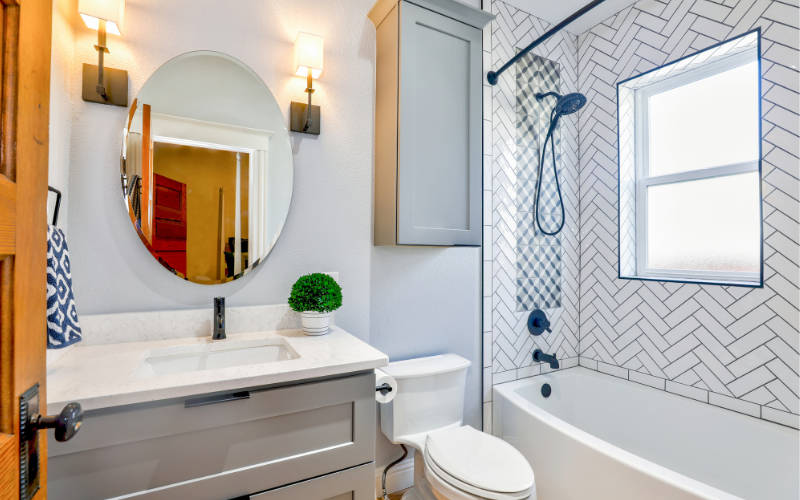With the global average family size now set at around 4.9 people, having one bathroom in your home may no longer be enough for the needs of expanding families? So you might be wondering if it is possible to add a bathroom to a house?
You can add a bathroom to a house as long as you have the space available. The ease of adding a bathroom to your house will depend on your floor structure. You can add a bathroom to most floor structures, but it is more difficult to add a bathroom to a house with a concrete slab.
Add a Bathroom instead of Moving House
More and more families are looking to adapt their current layout instead of moving to a bigger home due to the cost saving comparison.
Adding an extra bathroom to a house can increase the value of your home by as much as 5% – which generally outweighs the overall cost of installing a new bathroom.
If you’ve made the decision to stay and adapt the current layout of your home, instead of moving to a new house, then there are a few questions that need to be considered and answered before any building work takes place.
This is to make sure the overall integrity of the structure isn’t compromised.
- Is the existing plumbing adequate enough to handle the extra pressure?
- Does the current space available allow for what I need and is the space big enough for my requirements?
- Will there be enough natural or electrical light?
- Will I meet the necessary building regulations (dependent on country and location)?
You have two options; either choose to convert an existing room that no longer has a purpose; for example a pantry, laundry or storage room or build a completely new space within an existing room; an ensuite in the master or guest bedroom.
Will my existing plumbing support an extra bathroom?
If you’re planning on including a bathroom in your home then the location of this new addition in comparison to the existing soil pipe needs to be considered.
The key purpose of the soil pipe is to carry toilet waste to the sewer from your home, and this should be done on the most efficient and shortest route possible. It needs to run downhill as well as in a straight line to avoid future potential blockages and unwanted smells.
If the position of the new bathroom in relation to the existing soil pipe is quite a distance, it may be difficult to install everything you require in your new room and you may be required to pay higher costs to divert your soil pipe.
Floorboards in adjacent bedrooms will more than likely need to be lifted in order to access and extend the pipework that’s connected to your existing plumbing network.
However, there are occasions when the pipework will feed up the wall and head into the loft space if this is preferred.
The reasons for extending this pipework include to supply hot and cold water to the shower, and sink as well as providing the necessary elements to heat your radiators
Is my space big enough for an extra bathroom?
Depending on your location around the world, some rooms are required to be of a minimum size in order to be classed as ‘habitable’. This size and regulatory differs depending on where you are in the world.
You may also be limited to just a shower, toilet and sink only, which is perfect if the space is small and thin. This option is also ideal for families who are constantly busy, and prefer to have a quick shower instead of a long soak in the bath.
In order to be considered habitable, your new room must look to include adequate ventilation and natural light where possible.
Does the New Bathroom have enough Natural Light?
Natural lighting is proven to improve your overall mood, increase your mental health and reduce overall stress levels by making you feel much happier and relatively calmer.
Solutions for your natural lighting can come in the form of a sun tunnel (or light tunnel); a unique piece of equipment that allows light to travel from the roof, through the roof space into the room below providing a fantastic option for natural lighting.
Another solution would be the addition of double glazed vertical or roof windows at a minimum. Anything single glazed will increase the likelihood of condensation appearing on the panes due to the moisture from the steam.
A common method is to combine natural light with artificial which allows you to save electricity during the day whilst natural daylight floods the room in question.
Does the New Bathroom have enough Ventilation?
Having adequate ventilation installed in your new bathroom is key to stopping moisture, condensation and eventually mould from appearing in your room.
The installation of an extractor fan directly onto the external wall to allow an escape for this steam and moisture will directly put a halt to mould wanting to grow.
An easy alternative is to install this into the roof space, with a grill installed in the ceiling and the moisture and steam escaping through the roof.
Inline fans are less susceptible to producing noise which massively reduces any disturbances if you need to use the room in the dead of night.
Installing a Bathroom on an existing Concrete Slab
While this is a bit more difficult you can install a bathroom on an existing concrete slab but it is possible.
There are two ways that this can be done. The most seamless and expensive method involves cutting through the concrete slab with a demolition saw and diamond blade. From there new pipe lines can be laid and then the concrete slab is filled in again.
The other way is to use using in-wall electric macerator pump that means you do not need to cut your slab. Remember, not only do you need sewerage lines, but you also need hot and cold water supply for your taps.
Check with local building regulations to add an extra bathroom
In most cases when creating a new area where a bathroom wasn’t previously, local building regulations will need to be involved in the overall inspection and ultimately they’ll need to sign off that they’re happy with the overall work.
There’s a number of reasons why local building regulations will need to be involved and these include making sure:
- There is adequate ventilation in the room
- All the electrical components have been fit and tested correctly
- The fire safety aspect of the room in conjunction with the overall layout of the property
- The drainage put in place will remove all necessary waste
- To inspect and review the structural integrity of the building.
The inspection process will not be as rigorous as if you were building an extension to house the new bathroom.
Including the relevant local authorities at all stages of your installation lowers the possibility of having to tear down your installation and starting again if all of the aspects listed above have not been met.
Is adding an Extra Bathroom to your House a Good Idea?
It’s highly recommended to always use a professional when attempting to add a bathroom to your house. They will be aware of exactly what is required and can recommend ways around any potential obstacles in your property.
Hiring a professional can also save you a lot of money in the long run if you see this as a weekend DIY project. You may cut through something causing irreparable damage to your home which could have been avoided.
Once speaking to the professional and discussing what it is you’re after, the next step would be to contact your local council or building regulations authority to make them aware of your intention to begin this project.
They will be able to let you know if they need to be involved at any or all stages, but also they’re a fantastic source of information for relevant contact numbers and helpful details as you move forward with adding a bathroom to your house.
Need a great range of cutting and demolition tools, Paragon Masonry tools has a great range of diamond tools for sale.
Let us know in the comments your experiences with adding a new bathroom to an existing house and what advice you would give those looking to buy or build their own!



